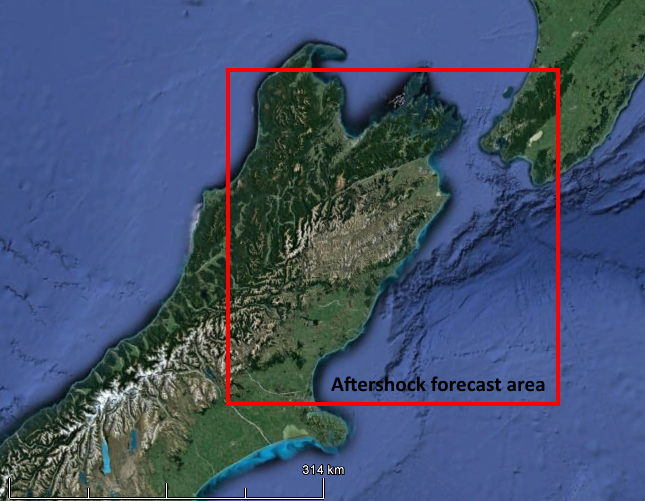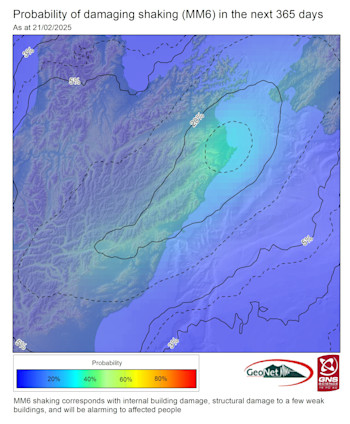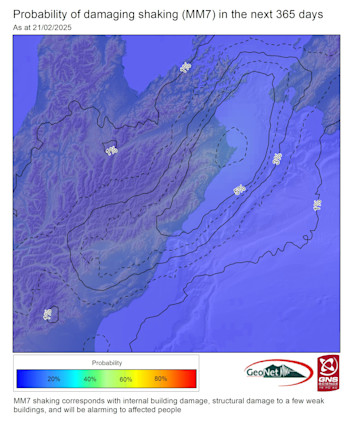Earthquake forecasts
Aftershock Forecasts
While no one can yet scientifically predict earthquakes, we can provide forecasts of future aftershocks (based on probabilities) from what is most likely to happen to what is very unlikely, but still possible. Most earthquake aftershock sequences decay (i.e. the number of earthquakes generally decreases) over time, with spikes of activity that can include larger earthquakes.
| Average number of M5.0-5.9 | Range* of M5.0-5.9 | Probability of 1 or more M5.0-5.9 | Average number of M6.0-6.9 | Range* of M6.0-6.9 | Probability of 1 or more M6.0-6.9 | Average number of M≥7 | Range* of M≥7 | Probability of 1 or more M≥7 | |
| within one year | 4 | 0-10 | 88% | 0.4 | 0-2 | 29% | 0.03 | 0-1 | 3% |
Forecast for rectangular box (see map below) with the coordinates -40.7, 171.7, -43.5, 171.7, -43.5, 175.5, -40.7, 175.5 at 12 noon, Friday February 21 2025; 95% confidence bounds.
The aftershocks of the magnitude 7.8 Kaikōura earthquake are mostly occurring throughout a broad area from North Canterbury through to Cook Strait that surrounds the faults that ruptured in that earthquake, although a few have occurred in the lower North Island. We forecast aftershock probabilities for the area in the red box on the map below. The area near the centre of the box (around Kaikōura) is more likely to experience felt aftershocks than areas towards the edge of the box. See the MMI map below for more information on the forecast shaking. Earthquakes can and do happen outside this box, but the box represents the most likely area for aftershocks in this sequence.
For example, there is a 29% chance of one or more M6.0-M6.9 within the next year. We estimate there will be between 0 and 2 earthquakes in this magnitude range within the next year.
The current rate of M6 and above earthquakes for the next year is about 1.5 times larger than what we would normally expect for long term seismicity represented in our National Seismic Hazard model. As the aftershock rates decrease, this difference will decrease as well..
Aftershock shaking forecasts
We have also calculated the probability of strong and severe earthquake shaking from aftershocks over the next year (starting 21 February 2025). On the Modified Mercalli Intensity (MMI) scale Strong shaking is classed as MM6, and severe as MM7. The MMI scale is different to earthquake magnitude – it describes the intensity and impacts of the shaking, which depend on the magnitude of the earthquake, how far away the earthquake was and the type of ground you are on. At MM6 intensity shaking levels, walking steadily is difficult, furniture and appliances may move on smooth surfaces, and objects fall from walls and shelves; glassware and crockery break; slight non-structural damage to buildings may occur. At MM7 intensity shaking levels, it is difficult to stand; furniture and appliances move; contents are damaged; there is minor building damage and liquefaction can occur in susceptible sediments.
The maps show the probability of MM6 and MM7 shaking within the aftershock region, which includes Wellington. Over the next year the probability of MM7 shaking is largest in the area of Cape Campbell at around 6%. In comparison, the probability of MM7 shaking in the Wellington area is around 3% (dark blue) in the next year. This highlights that it is possible for shaking similar to what occurred during the mainshock to happen again in Wellington.
Can't get enough technical information? Read the fine print on how we model aftershock probabilities here:
What has happened since 2016?
In the weeks following the M7.8 Kaikōura earthquake there were more than 11,000 earthquakes recorded within the aftershock forecast area. The table below shows how the number of recorded earthquakes has gone down over time.
| Year | Earthquakes (Located within the aftershock forecast area shown in the map below) |
| 2016 (up to 13/11/2016) | 2695 |
| 2016 (14/11/2016 to 31/12/2016) | 11083 |
| 2017 | 10115 |
| 2018 | 4305 |
| 2019 | 4301 |
| 2020 | 3121 |
| 2021 | 2874 |
| 2022 | 2820 |
| 2023 | 2878 |
Are you prepared?
Remember Long or Strong, Get Gone: If you are near the coast and feel a strong earthquake that makes it hard to stand up OR a weak rolling earthquake that lasts a minute or more move immediately to the nearest high ground or as far inland as you can, out of tsunami evacuation zones.
The National Emergency Management Agency (NEMA) has a great website with information on what to do before, during and after an earthquake.
Prepare your home. Protect your whānau.
There's a lot you can do to make your home safer and stronger for natural hazards. Every step you take will reduce the impact of a disaster on you and your family, so get started today. Check out the Natural Hazards Commission website on how to get your home, apartment, or rental prepared for a natural disaster.





